Share and Care in 20x20 Format - A Knowledge Sharing Event

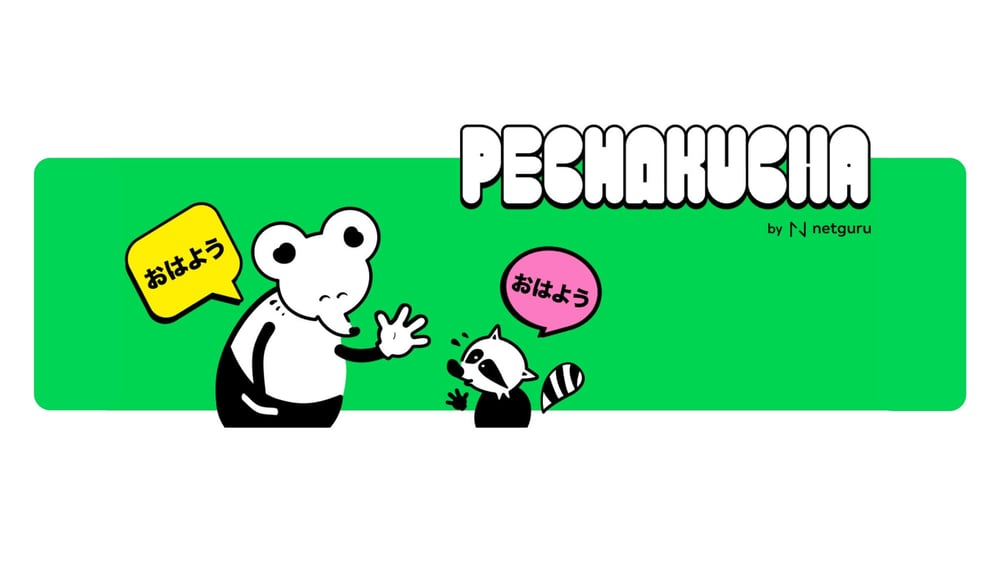
If there’s one thing that makes us so proud to work at Netguru, it’s the fact that we believe sharing is caring.
As a team of 75 designers, we produce a ton of internal knowledge-sharing materials. To give some context on the 2020 rollout – we created 20 hours of watching and 2 hours of reading overall.
But how to share and care… and respect our team member’s time? This is a short story of how we implemented a knowledge-sharing framework for our fully remote design team.
A trip down memory lane (Discovery)
We set a goal - implementing a knowledge-sharing framework that will boost content consumption by limiting consumption time, absorbing it, and packing it up with different topics instead of focusing on one. It would be best if we could make it both condensed and entertaining.
The perfect format happened to be named Pechakucha (Japanese for chit chat). In the last 20 years, it has been a widely-popularized storytelling format where a presenter shows 20 slides for 20 seconds of commentary each. This format was presented to a wider audience in February 2003 by Klein and Mark Dytham of Tokyo's Klein-Dytham Architecture (KDa). The "talk less, show more" convention is about sharing knowledge and experience on topics that we are passionate about. The subject does not matter unless we are eager to share and exchange ideas.
Its advantages? A conveniently short format (6 min 40 sec per 1 presentation) and low-effort character encouraged us to test it.
Why is Pechakucha worth a try?
- Conveniently short format,
- Stories led by visuals,
- Low-effort character.
Start small, think big (Exploration)
Our exploration began at the heart of the subject – on pechakucha.com. We browsed through online event recordings on YouTube and past local events from the design community like Dribbble meetups, Tipi UX, and Element talks.
“Start small,” they say, hence we gathered the insights and decided to test the format locally in our Poznan office by focusing on sharing what was exciting to us – hobbies, art, etc. But think big! From the early beginning we knew we’d like to scale the format, maybe even outside the company. And what does every event need aside from motivated people and format? Eye-catching visuals and strong marketing communication!
Where to start?
- Research the market to learn best practices,
- Set your eyes on the goal and think big
- Start small, but prepare to scale.
Konichiwa!
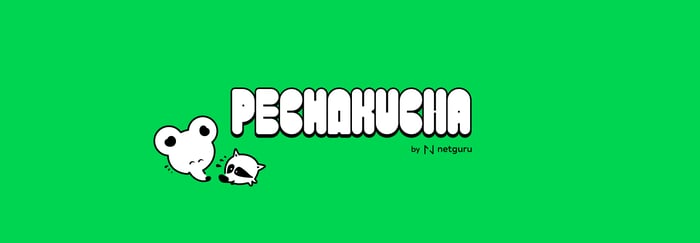
And this is how our brand characters: Pecha & Kucha were born along with custom typography designed by Damian. We have sent the first Slack announcement to our design community and found people interested in presenting. All set, the new event was born and we couldn’t wait to see it taking its first steps into our organization!
What’s next?
- Design a beautiful experience with strong branding.
- Attract your audience with engaging marketing.
- Find engaged peers to help you start.
Try again. Fail again. Fail better. (Testing)
6 PM, Thursday. We managed to gather 5 team members including us, the rest simply didn’t show up or resigned at the last minute. We felt like we had failed. Even though the test run was a great experience, our presentations were interesting, and we had a nice time with the people who showed up, we didn’t achieve our goal of gathering the whole local team together. We gave up, in hindsight, quite quickly.
Try again
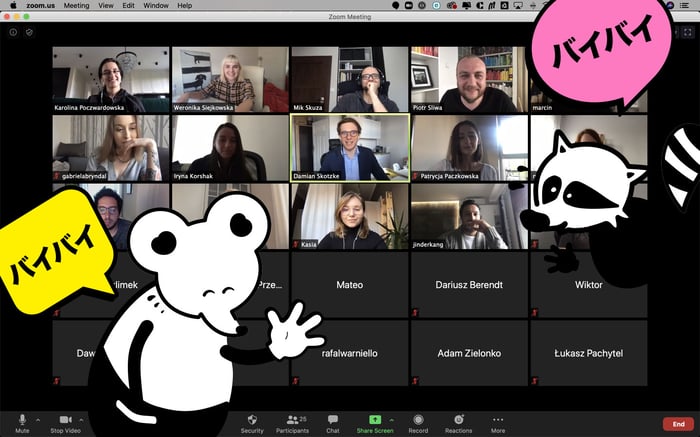
Based on our individual experience from remote workshops and meetings, we adapted Pechakucha to the online reality. Starting with informing our management about the new initiative, focusing on design-related topics, continuing with the right choice of tools, up to new marketing communication.
We were slightly nervous, but felt more than ready for our first online rockstar knowledge sharing initiative – Pechakucha for the Netguru Design Team!
We hit the jackpot, it was a great success with more than half – 28 individuals – of the team attending. The atmosphere was great, teammates got involved, and our speakers managed to dive into this quite challenging format smoothly. It worked!
How to start again?
- The world, your company, and your team are live organisms – react to change,
- Gain from other’s experience,
- Prepare and test your setup carefully.
Fail again

We placed emphasis on better onboarding for our speakers by preparing a template for joint presentations and a speaker guide covering all tips & tricks for our speakers. Dedicated Slack channel and onboarding calls were supposed to create an open space for asking questions regarding the format and event setup.
We did it. Speakers performed perfectly and the diversity of subjects was satisfying. Q&A sessions went smoothly thanks to the right choice of tools, such as after-event team building activities. It was also way easier to divide our responsibilities and have one host and one person dedicated to technical setup. A success story, you might think. And yet the results didn’t meet our expectations because event attendance decreased significantly.
How to improve?
- Gather feedback through forms and listen,
- Look for best tools on the market,
- Try to automate your work.
Fail better
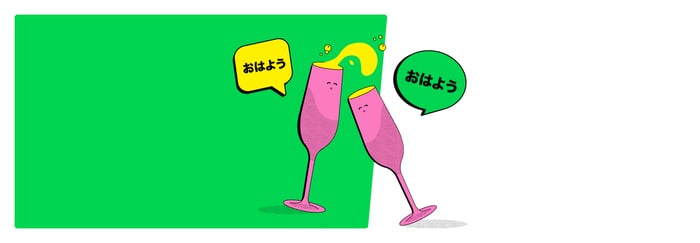
It wasn’t a success story all the way through, but simply a product development journey that made us grow and learn with each step taken. The most valuable lesson learned was not to be afraid to fail, as each failure motivated us to try harder and well, fail even better.
All the way back to the product (Lessons learned)
These few tips can ease your life as a host or an organizer and let you build upon it.
You do not have to do everything by yourself
We learned that trying to completely control the process and keeping yourself in its funnel can overcomplicate straightforward actions. From the beginning, we tried to unburden our speakers by collecting their presentations and inserting and ordering them in the deck ourselves. When we ran the second edition we found out during the event that we have not included the background to one of our speakers' presentations, because we mindlessly copied/pasted content we decided to change it.
We created a joint deck where we asked our speakers to input their slides until a certain deadline before the event. Not only was it not a burden, but it also became a chance for them to do a quality review in comparison to other presentations or implement changes without being dependent on us. Today, we know that delegation does not have to be a burden, but a tool of power.
Do not be a robot and automate
Doing everything from scratch or duplicating the last edition’s documents and cleaning them from content is quite... inefficient. We soon realized that we would miss something or get stuck with a pack of Frankenstein monsters if we would not approach it from a more product-ish angle.
We analyzed the materials from the past edition and created templates and quality checklists for Hosts and Speakers. Additionally, we packed our brand materials (logos, avatars, etc.) and enabled our speakers to download and reuse their presentations. These few simple steps have saved us a lot of time and effort. We could put micro tasks aside and focus on the big, meaningful ones.
Culture works within a time frame
Our initial approach was to conduct Pechakucha after working hours. We assumed that it would be relieving for people to sit with something to eat or drink after a day of work, with a clear head, connect with others, exchange knowledge, and share interests. After the second event, we realized that we were gravely wrong. The first edition went smoothly due to excitement about the new initiative, but we were left with a few attendants apart from eager-to-share speakers when it passed.
We realised that decreasing attendance may lead to lack of speakers' interest and drifting away from our goal. We decided to test the formula during the day. We got our managers’ approval and gave it a go. We had record-breaking results in attendance. We learned that if we want to grow company culture, we need to invest the company’s time. People want to be a part of that culture, but they also want to have their own life after it, and we have to respect it if we do not want to exclude them.
Reuse knowledge
When we were planning and organizing Pechakucha, we were purely focused on the internal domain. We wanted to fix the problem of knowledge sharing in our design department, and we lost the external perspective. We realized this after the 3rd edition when two of our speakers asked us if we could cut and enable them to reuse their speaking parts on channels like LinkedIn. For us, it became a quiet reminder to look at the content as a multipurpose medium instead of a one time gig.
Customer Value Proposition at its best
Having a mission and good intentions is not enough even in building a design culture in the company. We expected people to join every event in great numbers because they can learn, network, and fit their time schedules. In the beginning, we started by answering the last problem.
Although we realized it is not enough with every next edition, people tend to drift away when initial excitement passes. We constantly need to improve to keep people hyped, interested, and make their time worthwhile. Running events in an organization is all about asking ourselves what value we can offer to our recipients and experimenting with this matter. It is just like a product.
Sugoi! (Summary)
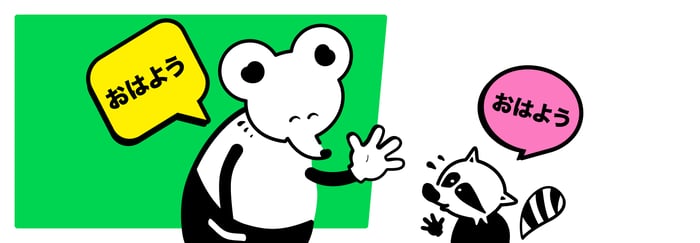
If you are considering starting a similar event on your own in your studio, company or local community, do not hesitate to do it. There are so many great stories to tell, and it would be a pity to let them get lost.
--
Damian Skotzke is a co-author of this article.
Tags





-1.jpg?width=362&height=188&name=Posts02%20(1)-1.jpg)
